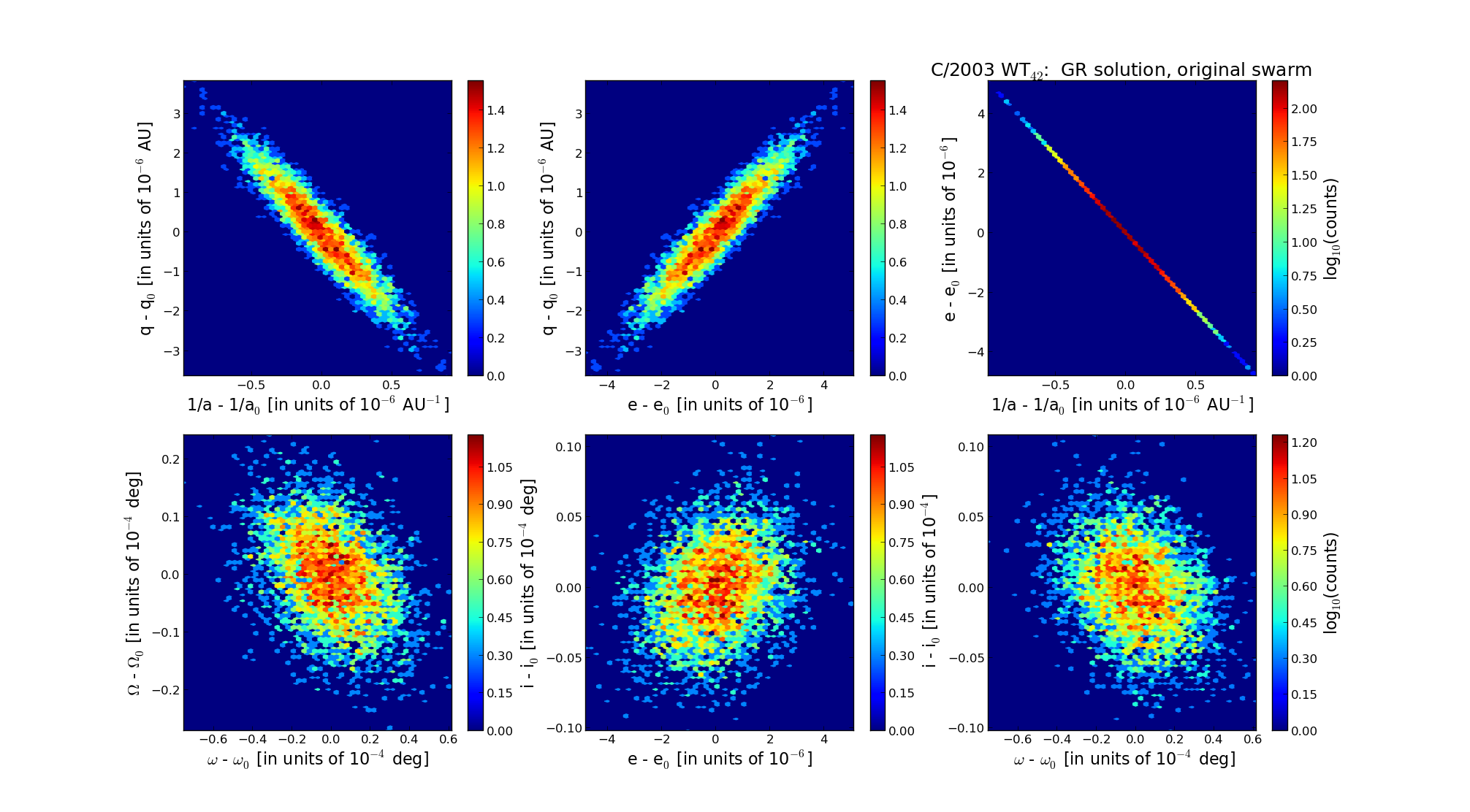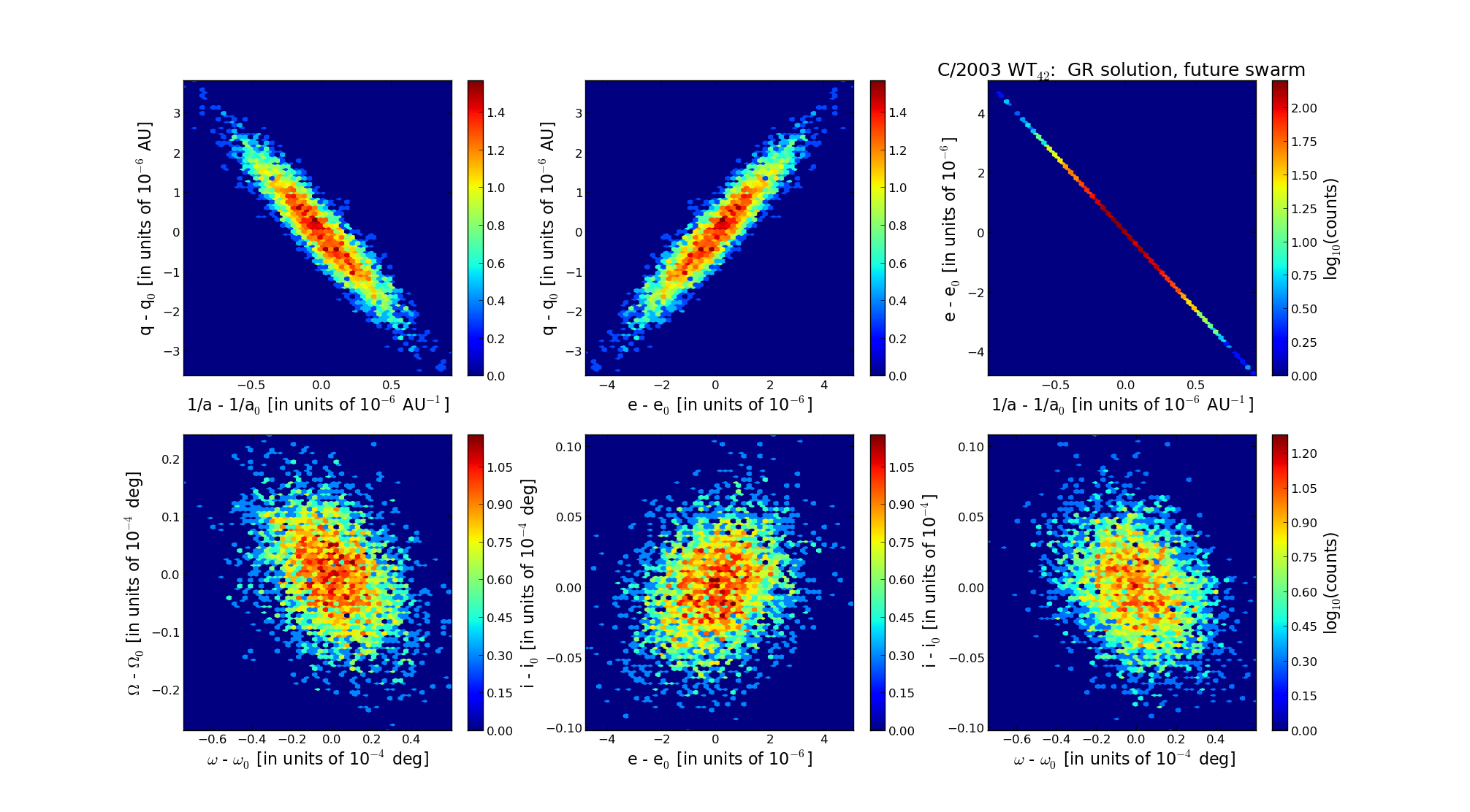| Solar System Dynamics & Planetology Group |
 |
C/2003 WT42 LINEAR |  |
| Solar System Dynamics & Planetology Group |
 |
C/2003 WT42 LINEAR |  |
| number of observations | 2564 |
| number of residuals | 5071 |
| data interval | 2003 Oct. 30 — 2008 May 25 |
| rms [arcsec] | 0.46 |
| orbit quality class | 1a+ |
| Epoch (TT) | 20060415.0 | = JD 2453840.5 |
| time of perihelion passage (TT) | 20060410.767044 | ± 0.000157 |
| perihelion distance | 5.19092150 | ± 0.00000101 |
| eccentricity | 1.00256151 | ± 0.00000135 |
| argument of perihelion [deg] | 92.467272 | ± 0.000018 |
| longitude of the ascending node [deg] | 48.453876 | ± 0.000007 |
| inclination [deg] | 31.410659 | ± 0.000003 |
| inverse semimajor axis [10-6 au-1] | -493.46 | ± 0.26 |

| Epoch (TT) | 17000419 | |
| time of perihelion passage (TT) | 20060411.899846 | ± 0.000159 |
| perihelion distance | 5.18221697 | ± 0.00000113 |
| eccentricity | 0.99975762 | ± 0.00000136 |
| argument of perihelion [deg] | 92.605011 | ± 0.000018 |
| longitude of the ascending node [deg] | 48.434892 | ± 0.000007 |
| inclination [deg] | 31.434394 | ± 0.000003 |
| inverse semimajor axis [10-6 au-1] | 46.77 | ± 0.26 |

| Epoch (TT) | 23140220 | |
| time of perihelion passage (TT) | 20060410.407702 | ± 0.000158 |
| perihelion distance | 5.18237935 | ± 0.00000108 |
| eccentricity | 0.99895846 | ± 0.00000135 |
| argument of perihelion [deg] | 92.354993 | ± 0.000018 |
| longitude of the ascending node [deg] | 48.405146 | ± 0.000007 |
| inclination [deg] | 31.423892 | ± 0.000003 |
| inverse semimajor axis [10-6 au-1] | 200.98 | ± 0.26 |
| number of observations | 1692 |
| number of residuals | 3339 |
| data interval | 2003 Oct. 30 — 2006 Aug. 04 |
| rms [arcsec] | 0.39 |
| orbit quality class | 1a+ |
| Epoch (TT) | 20060415.0 | = JD 2453840.5 |
| time of perihelion passage (TT) | 20060410.765562 | ± 0.000408 |
| perihelion distance | 5.19093047 | ± 0.00000277 |
| eccentricity | 1.00256017 | ± 0.00000181 |
| argument of perihelion [deg] | 92.466984 | ± 0.000053 |
| longitude of the ascending node [deg] | 48.453974 | ± 0.000009 |
| inclination [deg] | 31.410697 | ± 0.000004 |
| inverse semimajor axis [10-6 au-1] | -493.20 | ± 0.35 |
| Epoch (TT) | 17000419 | |
| time of perihelion passage (TT) | 20060411.898367 | ± 0.000406 |
| perihelion distance | 5.18222591 | ± 0.00000272 |
| eccentricity | 0.99975629 | ± 0.00000180 |
| argument of perihelion [deg] | 92.604724 | ± 0.000053 |
| longitude of the ascending node [deg] | 48.434990 | ± 0.000009 |
| inclination [deg] | 31.434433 | ± 0.000004 |
| inverse semimajor axis [10-6 au-1] | 47.03 | ± 0.35 |